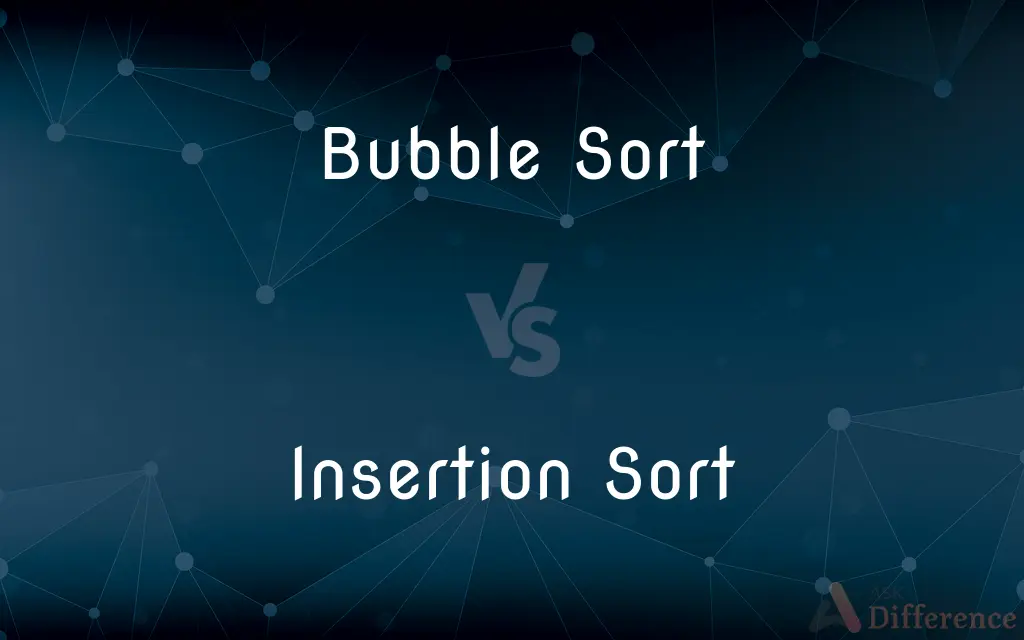Bubble Sort vs. Insertion Sort — What's the Difference?
By Tayyaba Rehman — Published on January 7, 2024
Bubble Sort repeatedly swaps adjacent elements if they are in the wrong order, while Insertion Sort builds a sorted array one item at a time by inserting elements into their correct position.

Difference Between Bubble Sort and Insertion Sort
Table of Contents
ADVERTISEMENT
Key Differences
Bubble Sort, a simple sorting algorithm, works by repeatedly stepping through the list, comparing adjacent elements and swapping them if they are in the wrong order. Insertion Sort, on the other hand, picks one element from the array at each iteration and places it at its correct position in the already sorted part of the array.
Bubble Sort is known for its simplicity but is less efficient on larger lists, as it requires multiple passes through the array. Insertion Sort is more efficient for small data sets or lists that are already partially sorted.
The time complexity of Bubble Sort in the worst and average cases is O(n²), where n is the number of items being sorted. Insertion Sort also has a worst-case and average time complexity of O(n²), but it can perform much better on nearly sorted lists.
In terms of implementation, Bubble Sort is straightforward and does not require much additional memory. Insertion Sort, while still simple, requires a bit more understanding of the concept of sorting a sub-list and inserting elements.
Bubble Sort is not commonly used in practical applications due to its inefficiency with large data sets. Insertion Sort, although better than Bubble Sort in some scenarios, is also often replaced by more efficient algorithms for large data sets.
ADVERTISEMENT
Comparison Chart
Method
Swapping adjacent elements
Inserting elements into sorted sub-list
Efficiency
Less efficient, especially for large lists
More efficient for small or nearly sorted lists
Time Complexity
O(n²) in worst and average cases
O(n²) in worst case, better for nearly sorted lists
Implementation
Simple, straightforward
Simple, but requires understanding of insertion
Use in Practice
Rarely used due to inefficiency
Used for small data sets or as part of more complex algorithms
Compare with Definitions
Bubble Sort
Inefficient for large data sets.
For the large dataset, Bubble Sort took a long time to complete.
Insertion Sort
Better performance on nearly sorted data.
Due to its nature, Insertion Sort worked fast on the almost sorted array.
Bubble Sort
Swaps elements if they are in the wrong order.
Bubble Sort compares and swaps adjacent elements to sort the list.
Insertion Sort
Involves sorting a sub-list and inserting elements.
Insertion Sort methodically created a sorted sub-list and expanded it.
Bubble Sort
A sorting algorithm that swaps adjacent elements.
Bubble Sort was used to sort the small array of numbers.
Insertion Sort
Builds a sorted array by inserting elements.
Insertion Sort was used to organize the list of names alphabetically.
Bubble Sort
Known for its simplicity in implementation.
Beginners often learn Bubble Sort first due to its straightforward logic.
Insertion Sort
Picks elements and places them in the correct position.
Each element was placed in its correct spot using Insertion Sort.
Bubble Sort
Repeatedly steps through the list for sorting.
Bubble Sort keeps iterating through the list until it's fully sorted.
Insertion Sort
Efficient for small or partially sorted lists.
The nearly sorted list was quickly organized using Insertion Sort.
Common Curiosities
How does Insertion Sort work?
It sorts by inserting each element into its correct position in a sorted sub-list.
What is the time complexity of Insertion Sort?
O(n²) in the worst case, but more efficient for nearly sorted lists.
Can Insertion Sort be used for large arrays?
It's generally more efficient than Bubble Sort but not ideal for large arrays.
Is Bubble Sort efficient for large data sets?
No, it's inefficient for large lists due to its O(n²) time complexity.
When is Bubble Sort used?
Typically in educational contexts or for very small data sets.
What is the main disadvantage of Bubble Sort?
Its inefficiency, especially with large or complex data sets.
How does Bubble Sort handle duplicate values?
It handles them well, maintaining their relative order.
Is Bubble Sort stable?
Yes, it maintains the relative order of equal elements.
What is Bubble Sort?
A simple sorting algorithm that repeatedly swaps adjacent elements.
What type of data set is best for Bubble Sort?
Small or simple data sets where efficiency is not a primary concern.
What is a practical application of Insertion Sort?
It's useful in scenarios where data is nearly sorted or for small arrays.
Why choose Insertion Sort over Bubble Sort?
Insertion Sort is often faster and more efficient for small or nearly sorted data sets.
How does the complexity of Insertion Sort compare to other algorithms?
It's less efficient than more advanced algorithms like quicksort or mergesort.
Does Insertion Sort require additional memory?
No, it sorts in place and requires minimal additional memory.
Can Insertion Sort be optimized?
Yes, by implementing binary insertion sort or using it as part of more complex algorithms.
Share Your Discovery

Previous Comparison
Half Adder vs. Full Adder
Next Comparison
If-else vs. SwitchAuthor Spotlight
Written by
Tayyaba RehmanTayyaba Rehman is a distinguished writer, currently serving as a primary contributor to askdifference.com. As a researcher in semantics and etymology, Tayyaba's passion for the complexity of languages and their distinctions has found a perfect home on the platform. Tayyaba delves into the intricacies of language, distinguishing between commonly confused words and phrases, thereby providing clarity for readers worldwide.
















































